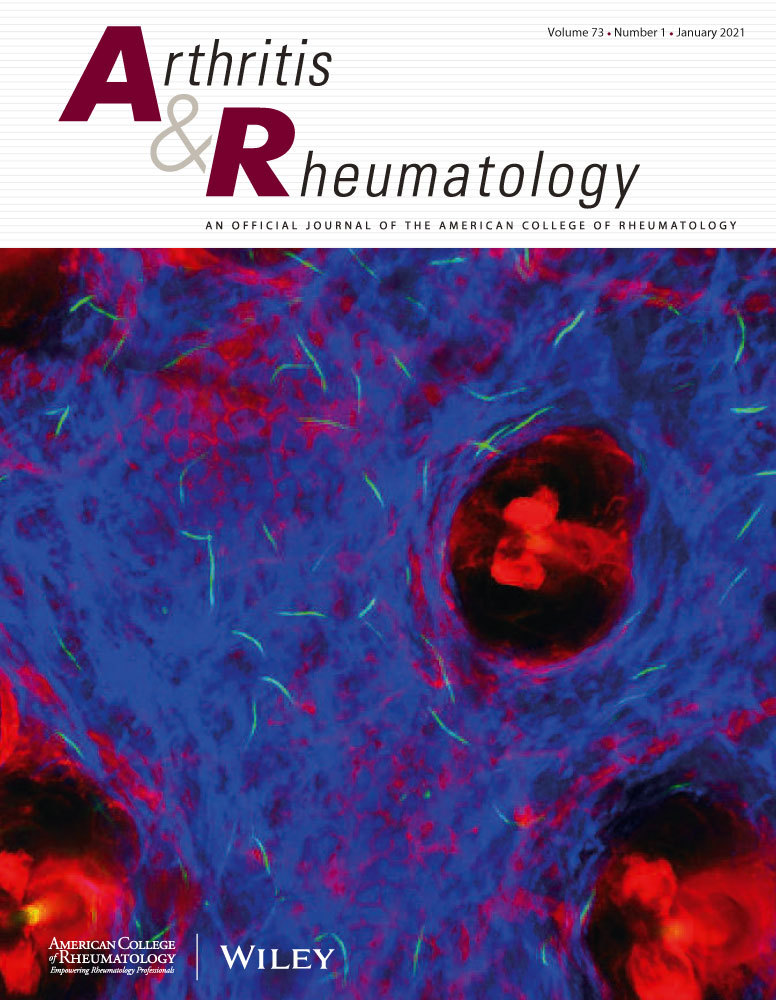儿童关节炎和风湿病研究联盟多关节JIA共识治疗方案研究的三年结局和潜在类别轨迹分析
IF 11.4
1区 医学
Q1 RHEUMATOLOGY
引用次数: 0
摘要
目的通过CARRA停止-JIA多关节JIA (pJIA)共识治疗计划(ctp)研究,评估初始生物DMARD (bDMARD)治疗时间差异对3年预后的影响。方法经CARRA注册中心随访3年的stop - jia参与者符合条件。结果包括ACR临床无活性疾病(CID)停用糖皮质激素,临床青少年关节炎疾病活动评分(10个关节)无活性疾病(cJADAS-10- id: cJADAS-10≤2.5),临床药物缓解(CRM), CID和/或cJADAS-10- id的时间比例。应用潜在类轨迹模型(LCTM)来确定在此期间具有相似疾病病程的参与者亚组。结果共纳入297例受试者,其中Step Up [SU] 190例,Early Combination [EC] 76例,Biologic First [BF] 31例。在3年的随访中,CID分别达到35%、42%和44% (SU与EC的p=0.35)。EC在实现客户关系管理方面优于SU (59.9% vs 40.6%;p=0.012),在CID中花费的时间(38% vs 30%;p=0.04)和cJADAS-10-ID (51% vs 41%;p = 0.02)。LCTM确定了缓慢、中等和快速的改善轨迹;从基线开始的第一个月(OR 5.33)或第二个月(OR 2.67)内启动bDMARD与快速改善轨迹相关。结论:在反映疾病活动性降低时间的结果方面,sec优于SU。在2个月内开始bDMARD预示着非活动性疾病的快速改善和维持。这些结果支持了早期bDMARD启动降低pJIA总体疾病负担的假设。本文章由计算机程序翻译,如有差异,请以英文原文为准。
Three-Year Outcomes and Latent Class Trajectory Analysis of the Childhood Arthritis and Rheumatology Research Alliance Polyarticular JIA Consensus Treatment Plans Study.
OBJECTIVE
To assess the impact of differences in the timing of initial biologic DMARD (bDMARD) therapy using the CARRA STOP-JIA polyarticular JIA (pJIA) consensus treatment plans (CTPs) study on outcomes through 3 years.
METHODS
STOP-JIA participants with CARRA Registry follow-up through 3 years were eligible. Outcomes included ACR clinically inactive disease (CID) off glucocorticoids, clinical Juvenile Arthritis Disease Activity Score (10 joints) inactive disease (cJADAS-10-ID: cJADAS-10≤2.5), clinical remission on medication (CRM), and proportion of time in CID and/or cJADAS-10-ID. Latent class trajectory modeling (LCTM) was applied to identify participant subgroups sharing similar disease courses over this period.
RESULTS
297 participants were included (n=190 Step Up [SU], 76 Early Combination [EC], 31 Biologic First [BF]). At the 3-year visit, CID was achieved by 35%, 42% and 44%, respectively (p=0.35 for SU versus EC). EC was superior to SU in achieving CRM (59.9% vs. 40.6%; p=0.012), time spent in CID (38% versus 30%; p=0.04) and cJADAS-10-ID (51% versus 41%; p=0.02). Slow, moderate, and rapid improvement trajectories were identified by LCTM; bDMARD initiation within the first (OR 5.33) or second (OR 2.67) month from baseline was associated with the rapid improvement trajectory.
CONCLUSIONS
EC was superior to SU across 3 years for outcomes reflecting time spent in lower disease activity. Starting bDMARD within 2 months predicted rapid improvement and maintenance of inactive disease. These results support the hypothesis that early bDMARD initiation reduces overall disease burden in pJIA.
求助全文
通过发布文献求助,成功后即可免费获取论文全文。
去求助
来源期刊

Arthritis & Rheumatology
RHEUMATOLOGY-
CiteScore
20.90
自引率
3.00%
发文量
371
期刊介绍:
Arthritis & Rheumatology is the official journal of the American College of Rheumatology and focuses on the natural history, pathophysiology, treatment, and outcome of rheumatic diseases. It is a peer-reviewed publication that aims to provide the highest quality basic and clinical research in this field. The journal covers a wide range of investigative areas and also includes review articles, editorials, and educational material for researchers and clinicians. Being recognized as a leading research journal in rheumatology, Arthritis & Rheumatology serves the global community of rheumatology investigators and clinicians.
 求助内容:
求助内容: 应助结果提醒方式:
应助结果提醒方式:


